Choosing the right bike is an exciting endeavor, whether you’re a seasoned cyclist upgrading your ride or a newcomer eager to experience the joys of cycling. A crucial aspect of this process, often overlooked, is understanding bike frame measurements. Knowing How To Measure Bike Frame dimensions is essential for ensuring you select a bicycle that not only fits your body perfectly but also aligns with your intended riding style. This guide will walk you through the key measurements, providing you with the knowledge to confidently assess any bike frame.
If you’re in the market for a new bike or considering renting one, grasping these measurements becomes even more critical. Manufacturers don’t always adhere to uniform sizing conventions. A ‘medium’ frame from one brand might differ significantly from another. By learning how to measure bike frame accurately, you empower yourself to compare bikes effectively and ensure a comfortable and efficient riding experience.
This comprehensive guide will equip you with the knowledge and techniques to measure your road bike or mountain bike frame like a pro. Understanding these dimensions is the first step towards achieving optimal bike fit, enhancing performance and preventing discomfort. While we delve into measurements relevant for both road and mountain bikes, those venturing into off-road terrains might also find our detailed guide to mountain bike geometry particularly insightful, as many principles remain universally applicable. We also have resources to guide you on choosing the right size frame for road bikes and mountain bikes and specific advice for choosing a women’s bike.
Decoding Bike Geometry Measurements
Before we dive into the practical steps of measuring, let’s familiarize ourselves with the essential bike geometry terms. Understanding these measurements is the foundation for knowing how to measure bike frame effectively and interpreting the data. Here’s a breakdown of the key dimensions:
- Top Tube Length (Effective): This is the horizontal distance from the center of the head tube to the center of the seat post. It’s a crucial factor in determining the bike’s reach and overall riding position.
- Seat Tube Length: Measured from the center of the bottom bracket to the top of the seat tube, this dimension traditionally dictated frame size, though less so in modern bikes with sloping top tubes.
- Reach: Reach is the horizontal distance from the center of the bottom bracket to the top center of the head tube. It’s a vital measurement for determining the bike’s cockpit length and rider position.
- Stack: Stack refers to the vertical distance from the center of the bottom bracket to the top center of the head tube. It indicates the handlebar height relative to the bottom bracket.
- Wheelbase: The wheelbase is the distance between the front and rear wheel axles. It influences the bike’s stability and handling characteristics.
- Chainstay Length: This is the distance from the center of the bottom bracket to the rear axle. Chainstay length affects the bike’s responsiveness and climbing ability.
- Front Center: Measured from the center of the bottom bracket to the front axle, the front center contributes to the wheelbase and influences weight distribution and handling.
- Seat Tube Angle: This angle, measured between the seat tube and a horizontal line, affects rider position and pedaling efficiency.
- Head Tube Angle: The angle between the head tube and a horizontal line. It significantly impacts steering responsiveness and handling stability.
- Bottom Bracket Drop: Bottom bracket drop is the vertical distance the bottom bracket sits below the wheel axles. It influences stability and cornering ability.
- Bottom Bracket Height: The distance from the ground to the center of the bottom bracket. Bottom bracket height affects ground clearance and center of gravity.
Essential Tools for Measuring Your Bike Frame
To accurately measure your bike frame and truly understand how to measure bike frame dimensions, you’ll need to gather a few simple tools. These will ensure precision and make the process straightforward:
- Tape Measure: A standard tape measure, preferably metric, is essential for measuring lengths.
- Clinometer (or Smartphone App): A clinometer is used to measure angles. Many free smartphone apps are available that perform this function accurately.
- Long Spirit Level (or Straight Edge with Clinometer App): A spirit level ensures horizontal and vertical alignment. Alternatively, a straight piece of wood combined with a clinometer app can achieve the same result.
- Plumb Line (or String and Weight): A plumb line, or a simple string with a weight like Blu Tack, is used to establish a vertical reference for measurements like reach and stack.
While metric units are the standard in bike frame measurements, particularly for newer models, some manufacturers, especially in mountain biking, might still use inches. For consistency and ease of comparison, we recommend sticking to metric measurements (centimeters). If needed, conversion to inches can be done by dividing centimeters by 2.54.
It’s also worth noting that most bike manufacturers provide detailed geometry charts for their framesets on their websites. If your bike is a current model, consulting the manufacturer’s geometry chart is highly recommended. These charts offer precise measurements and can serve as a valuable reference point, often more accurate than manual measurements.
Step-by-Step Guide: How to Measure Each Dimension
Now, let’s get practical and explore how to measure bike frame dimensions step-by-step. Follow these instructions carefully for each measurement to ensure accuracy.
How to Measure Top Tube Length (Effective Top Tube)
 Demonstration of top tube measurement on a bike frame
Demonstration of top tube measurement on a bike frame
Traditionally, bike frames featured horizontal top tubes. Modern designs, however, often incorporate sloping top tubes. When discussing top tube length, geometry charts typically refer to the “effective top tube length” or “virtual top tube length.” This measurement provides a consistent standard regardless of the top tube’s slope.
The effective top tube length is the horizontal distance between the center of the head tube and the center of the seat post. To measure it accurately:
- Identify Center Points: Locate the center of your head tube and the center of your seat post.
- Horizontal Alignment: Use your spirit level or clinometer app to ensure your measurement is perfectly horizontal. Place the level against the top tube area, aligning it from the head tube center towards the seat post center.
- Measure: Measure the horizontal distance between the center of the head tube and the center of the seat post, maintaining the horizontal alignment.
Road bikes are frequently sized based on top tube length, although mountain bikes and some road bikes use S, M, L sizing. However, sizing can vary significantly between brands. A size S frame from one brand might have a top tube length equivalent to a size M from another. Even virtual top tube measurements can be interpreted differently by manufacturers. For instance, Colnago measures to a vertical projection from the top of the seat tube, resulting in shorter measurements compared to brands that account for seat post setback.
How to Measure Seat Tube Length
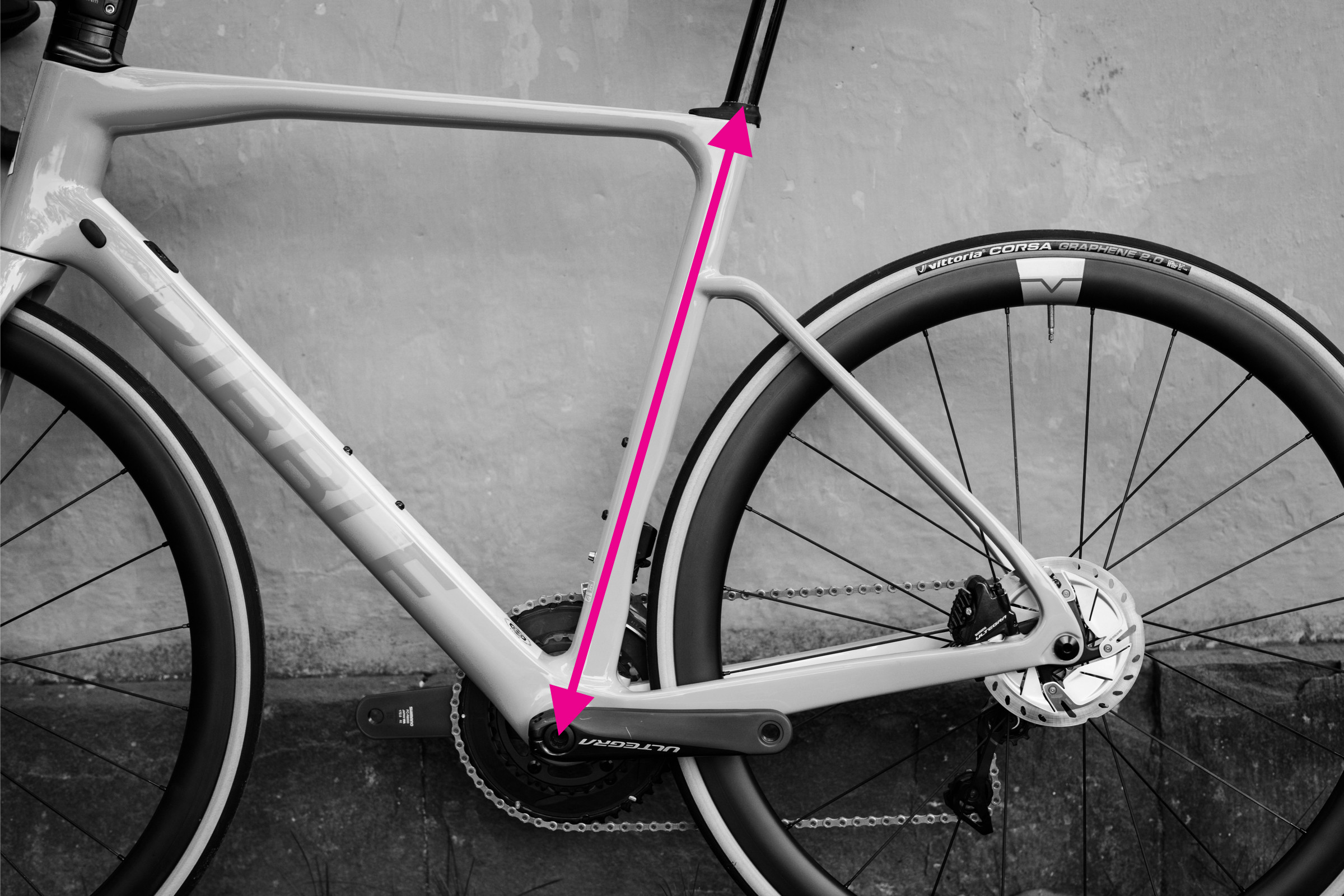 Demonstration of seat tube measurement on a bicycle frame
Demonstration of seat tube measurement on a bicycle frame
Seat tube length is the straight-line distance from the center of the bottom bracket to the top of the seat tube. While seemingly straightforward, some frame designs can complicate this measurement:
- Identify Measurement Points: Locate the center of the bottom bracket and the top of the seat tube.
- Straight Line Measurement: Use your tape measure to measure the straight-line distance between these two points.
- Account for Design Variations: Be mindful of seat tube extensions (like on Trek Madone) or seat masts, which might make direct comparisons challenging. Also, note that mountain bikes often have kinks in the seat tube; avoid following the tube’s curve and maintain a straight line from the bottom bracket center to the top of the seat tube.
Using a straight edge aligned from the bottom bracket center to the top of the seat tube can help ensure you’re following the correct line for measurement, especially if you’re unsure.
How to Measure Reach and Stack
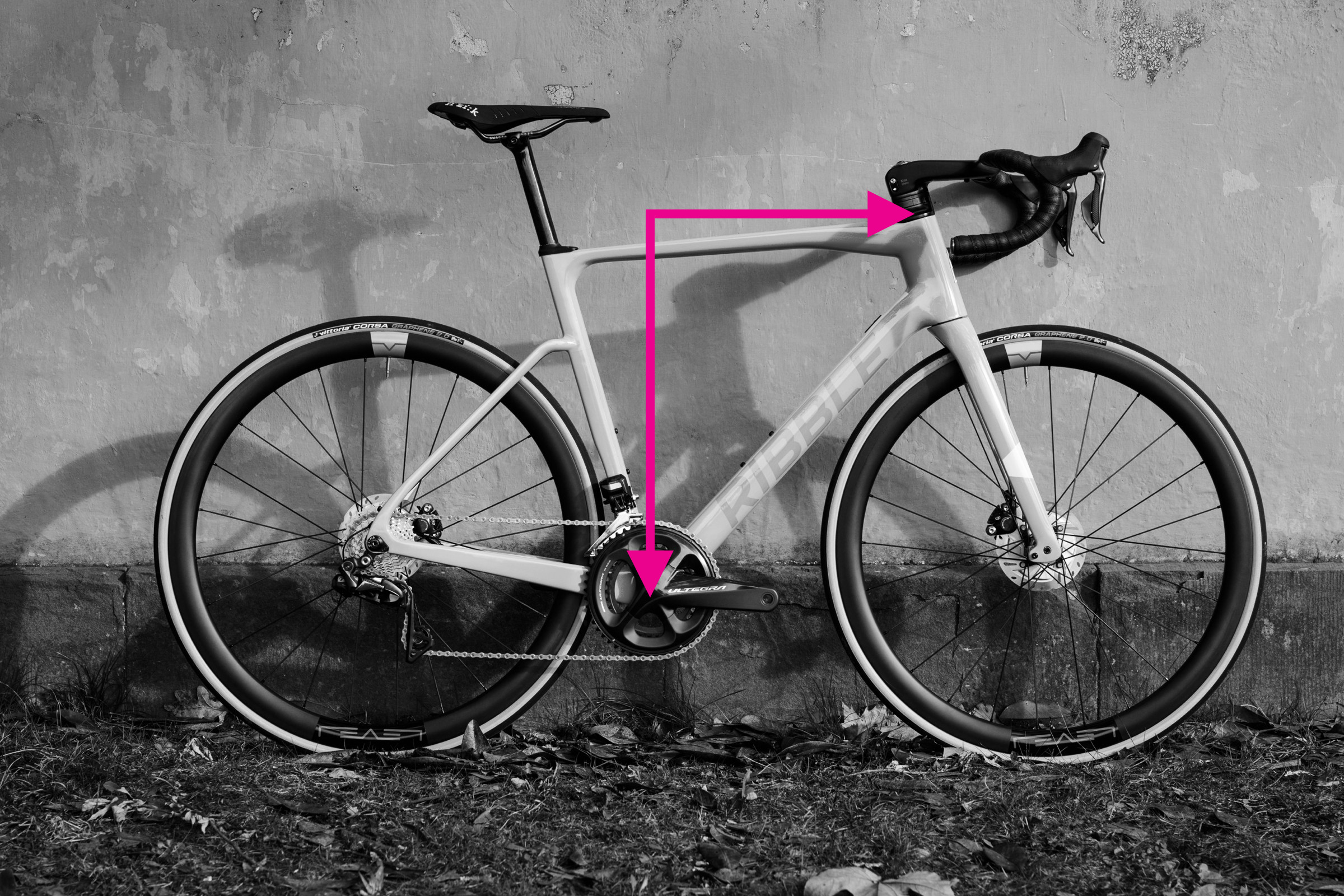 Demonstration of stack and reach measurements on a bike frame
Demonstration of stack and reach measurements on a bike frame
Reach and stack provide more consistent frame comparison metrics compared to top tube and seat tube lengths, as they are independent of frame design. They measure perpendicular distances between the bottom bracket and the top of the head tube, two critical contact points.
Reach: The horizontal distance between the bottom bracket center and the top center of the head tube.
Stack: The vertical distance between the bottom bracket center and the top center of the head tube.
To measure reach and stack:
Reach Measurement:
- Horizontal Level: Use your spirit level, aligning its top edge with the center of the top of the head tube.
- Plumb Line Setup: Attach a plumb line to the spirit level’s end, ensuring it hangs straight and the weight is symmetrical.
- Align Plumb Line: Adjust the level until the plumb line intersects precisely with the center of the bottom bracket spindle.
- Measure Reach: Measure the horizontal distance from the plumb line’s top point (where it meets the level) to the center of the head tube. This is your reach.
Stack Measurement:
- Vertical Measurement: Once set up for reach measurement, the vertical distance from the spirit level’s top edge down to the bottom bracket center (indicated by the plumb line) is your stack.
Alternatively, for stack, you can measure the vertical distance from the ground to the top of the head tube and then subtract the height of the bottom bracket from the ground.
Reach and stack measurements can be a bit tricky to capture accurately. Having a second person assist can be helpful, especially with the plumb line method. Repeating the measurements is recommended to ensure consistency and accuracy.
How to Measure Wheelbase
 Demonstration of wheelbase measurement on a bike frame
Demonstration of wheelbase measurement on a bike frame
The wheelbase, the distance between the front and rear axles, significantly affects a bike’s ride quality and varies with frame size. Measuring it is relatively simple:
- Fork Alignment: Ensure the front fork is pointing straight ahead.
- Measure Axle-to-Axle: Use your tape measure to measure the distance from the center of the front axle to the center of the rear axle.
- Repeat for Accuracy: Take multiple measurements, and ideally measure both sides of the bike and average the results, to compensate for any slight fork misalignment.
How to Measure Chainstay Length
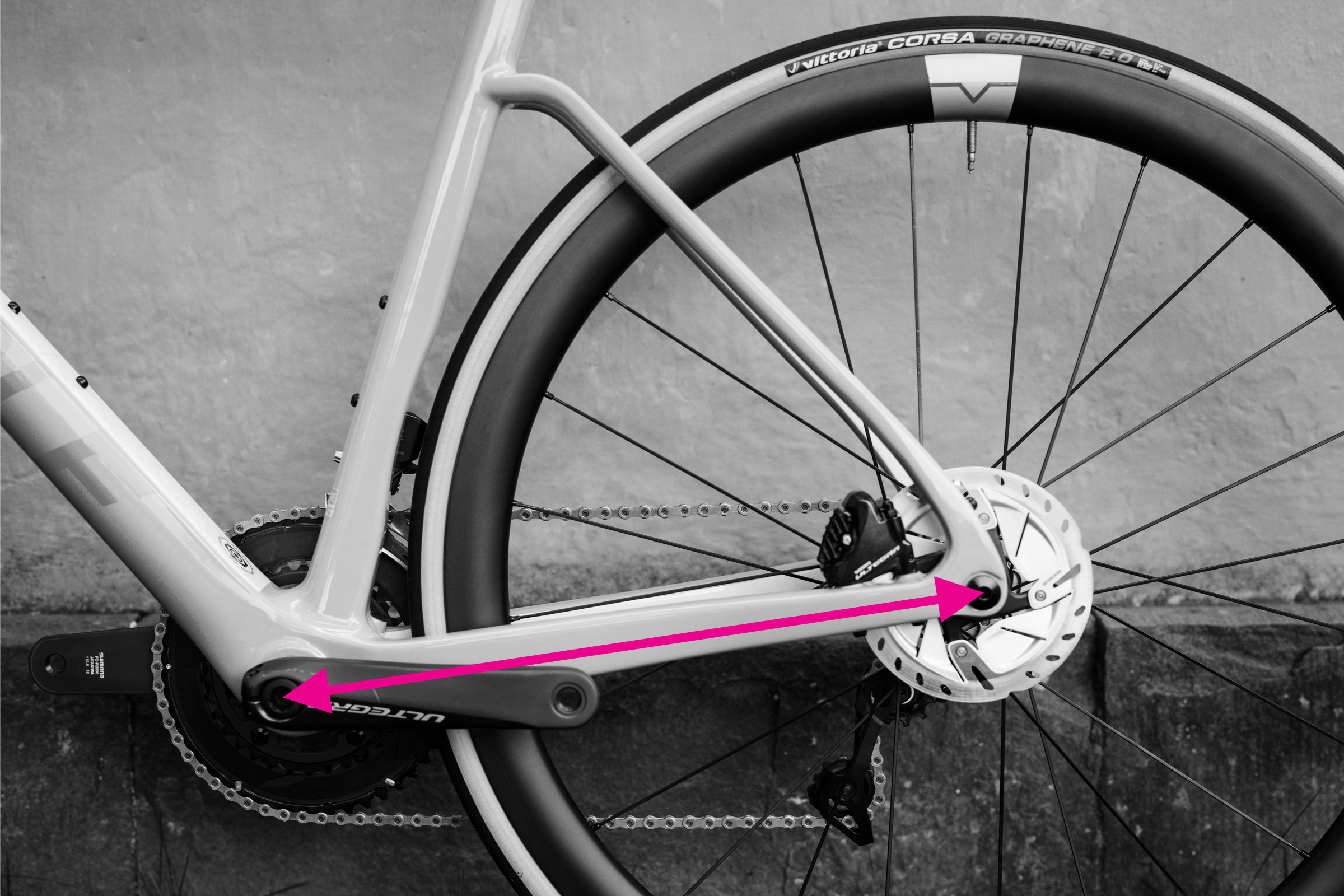 Demonstration of chainstay length measurement on a bike frame
Demonstration of chainstay length measurement on a bike frame
Chainstay length, a component of the wheelbase, plays a vital role in a bike’s handling. Shorter chainstays generally result in a more responsive and agile feel.
- Identify Measurement Points: Locate the center of the bottom bracket axle and the center of the rear dropout.
- Straight Line Measure: Use your tape measure to measure the straight-line distance between these two centers.
How to Measure Front Center
 Demonstration of front center measurement on a bike frame
Demonstration of front center measurement on a bike frame
Front center, the other component of the wheelbase, is analogous to chainstay length but measured to the front dropout. It influences handling and toe overlap.
- Identify Measurement Points: Locate the center of the bottom bracket axle and the center of the front dropout.
- Straight Line Measure: Measure the straight-line distance between these points.
While often less commonly quoted than other measurements, front center is still relevant for understanding a bike’s geometry. Note that wheelbase is not simply the sum of chainstay length and front center as these are not horizontal measurements.
How to Measure Seat Tube and Head Tube Angles
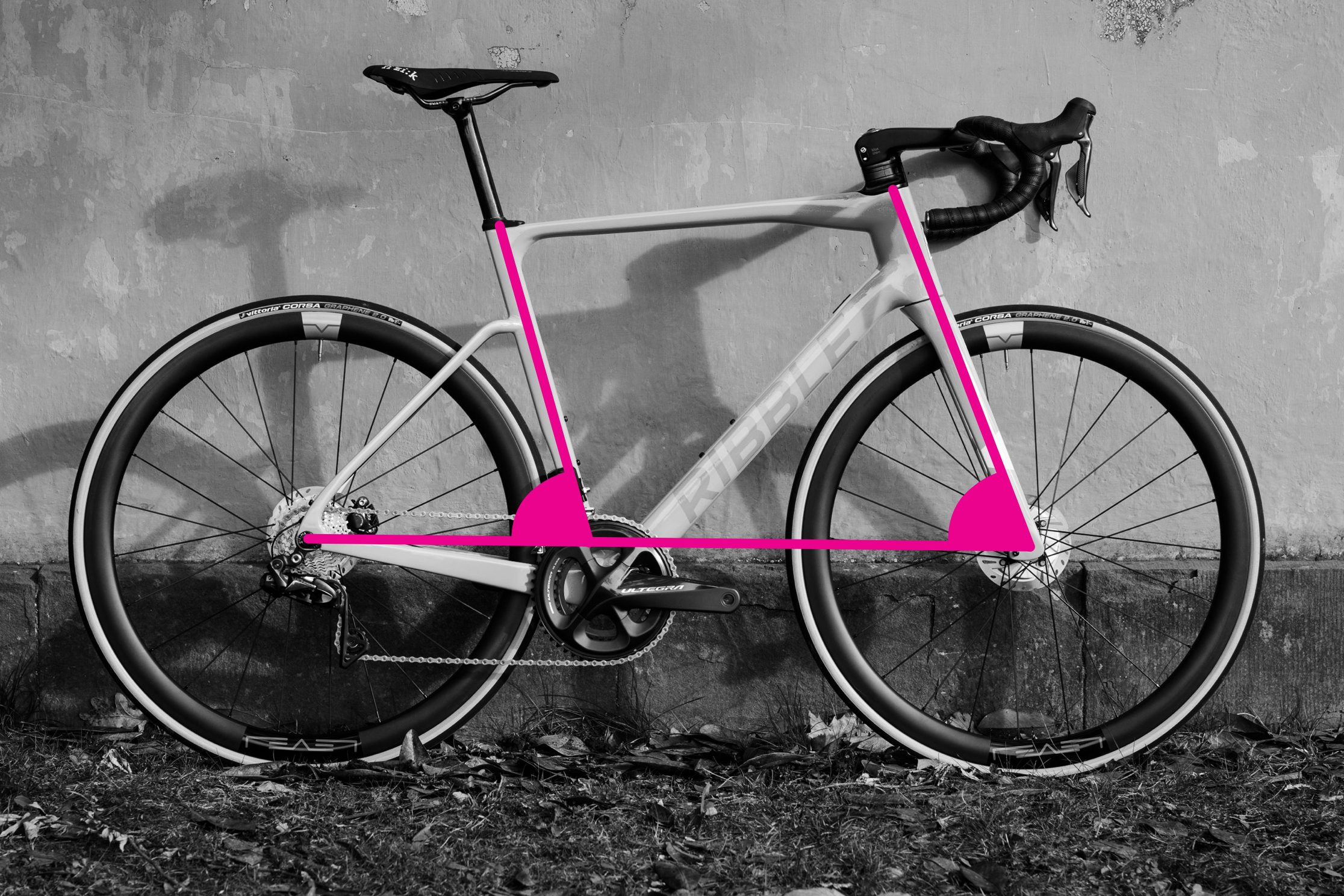 Demonstration of seat and head tube angle measurements on a bike frame
Demonstration of seat and head tube angle measurements on a bike frame
Seat tube and head tube angles are critical determinants of a bike’s handling. Steeper angles generally lead to quicker, more nimble handling. A clinometer app is invaluable for measuring these angles:
Seat Tube Angle:
- Vertical Bike: Ensure your bike is vertical and resting on a level surface.
- Clinometer Placement: Place your smartphone (with the clinometer app active) against the seat tube. If the seat tube is straight, align the phone directly against it.
- Account for Kinks: If there’s a kink, use a straight edge to create a line from the bottom bracket shell to the top of the seat tube, and align your phone with this straight edge.
- Read Angle: Read the angle measurement from the clinometer app.
Head Tube Angle:
- Clinometer Placement: Place your smartphone against the head tube.
- Tapered Head Tubes: For tapered head tubes, aim to align your phone with the centerline of the head tube. Alternatively, use a straight edge aligned with the centers of the top and bottom of the head tube.
- Fork Leg Angle (for Straight Forks): If your fork legs are straight, their angle will mirror the head tube angle, offering an alternative measurement point.
- Steerer Tube Extension: You can also measure the angle using the steerer tube extension above the head tube.
- Read Angle: Read the angle from the clinometer app. Ensure the bike remains vertical throughout the measurement.
How to Measure Bottom Bracket Drop
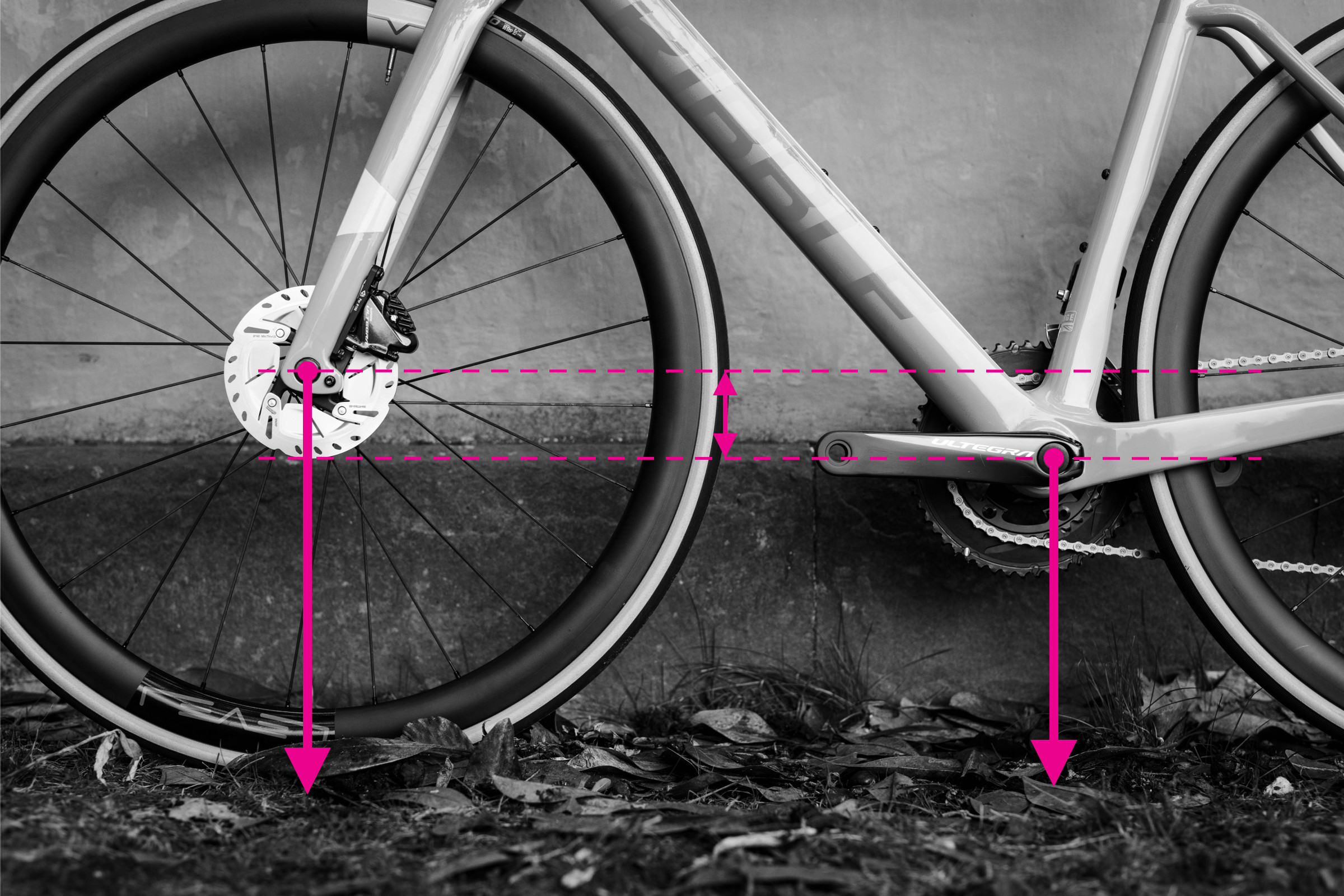 Demonstration of bottom bracket drop measurement on a bike frame
Demonstration of bottom bracket drop measurement on a bike frame
Bottom bracket drop is the vertical distance the bottom bracket sits below the wheel axles. It affects stability and cornering.
- Measure Rear Axle Height: Measure the vertical distance from the ground to the center of the rear axle.
- Measure Bottom Bracket Height: Measure the vertical distance from the ground to the center of the bottom bracket.
- Calculate Drop: Subtract the bottom bracket height from the rear axle height. This difference is your bottom bracket drop.
How to Measure Bottom Bracket Height
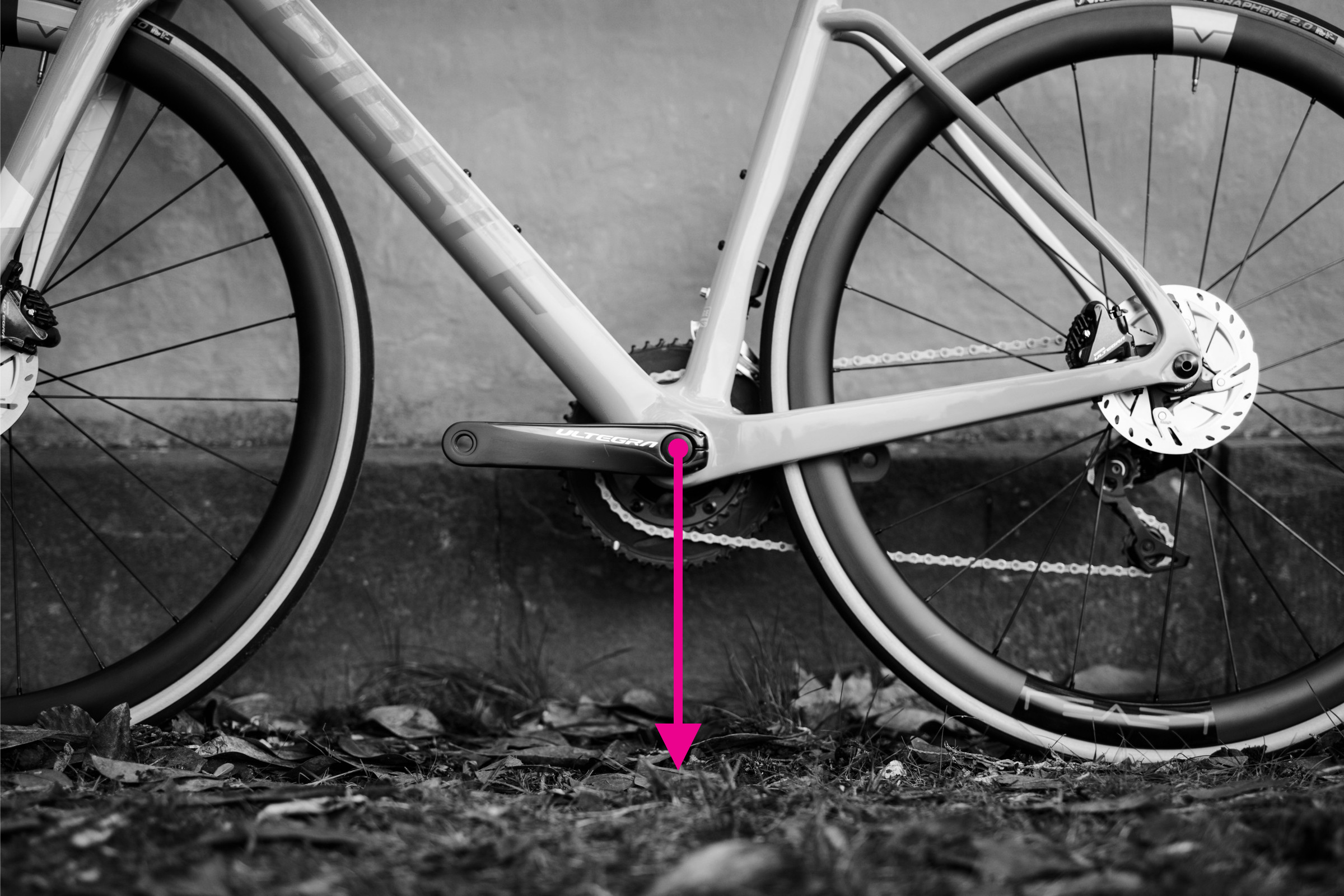 Demonstration of bottom bracket height measurement on bike frame
Demonstration of bottom bracket height measurement on bike frame
Bottom bracket height is simply the distance from the ground to the center of the bottom bracket shell.
- Vertical Bike: Ensure your bike is upright on level ground.
- Measure to Bottom Bracket Center: Measure the vertical distance from the ground to the center of the bottom bracket shell.
Remember that bottom bracket height can be slightly influenced by tire pressure, so ensure your tires are inflated to your typical riding pressure for the most accurate measurement.
Conclusion: Your Bike Frame Measurement Toolkit
Mastering how to measure bike frame dimensions empowers you with valuable knowledge for making informed bike purchasing decisions, whether you’re considering a brand new model, a second-hand bike, a practical commuting bike, or an adventurous gravel bike. By understanding these measurements, you can confidently assess frame sizes, compare different models, and ultimately choose a bike that fits you perfectly and enhances your cycling experience.
Keep your recorded measurements in a safe place. This information will be a valuable asset for future bike purchases and ensuring you always find the right frame for your needs.

